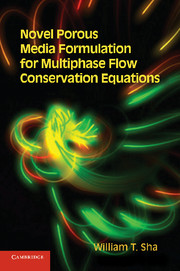Book contents
- Frontmatter
- Contents
- Figures and Table
- Foreword
- Foreword
- Foreword
- Nomenclature
- Preface
- Acknowledgments
- 1 Introduction
- 2 Averaging relations
- 3 Phasic conservation equations and interfacial balance equations
- 4 Local volume-averaged conservation equations and interfacial balance equations
- 5 Time averaging of local volume-averaged conservation equations or time-volume-averaged conservation equations and interfacial balance equations
- 6 Time averaging in relation to local volume averaging and time-volume averaging versus volume-time averaging
- 7 Novel porous media formulation for single phase and single phase with multicomponent applications
- 8 Discussion and concluding remarks
- Appendix A
- Appendix B
- Appendix C
- Appendix D
- References
- Index
3 - Phasic conservation equations and interfacial balance equations
Published online by Cambridge University Press: 07 October 2011
- Frontmatter
- Contents
- Figures and Table
- Foreword
- Foreword
- Foreword
- Nomenclature
- Preface
- Acknowledgments
- 1 Introduction
- 2 Averaging relations
- 3 Phasic conservation equations and interfacial balance equations
- 4 Local volume-averaged conservation equations and interfacial balance equations
- 5 Time averaging of local volume-averaged conservation equations or time-volume-averaged conservation equations and interfacial balance equations
- 6 Time averaging in relation to local volume averaging and time-volume averaging versus volume-time averaging
- 7 Novel porous media formulation for single phase and single phase with multicomponent applications
- 8 Discussion and concluding remarks
- Appendix A
- Appendix B
- Appendix C
- Appendix D
- References
- Index
Summary
The equations of conservation for a pure phase are given by continuum mechanics. Although a pure phase commonly refers to one physical phase, such as vapor, liquid, or solid, it also includes certain nonreactive mixtures, such as room atmosphere or an aqueous solution of glycerine. The identification of a phase in a multiphase system is best made in terms of its dynamic phases according to their different dynamic responses, despite the fact that they may be of the same material. For example, within the framework of generalized multiphase mechanics first suggested by Soo, particles or bubbles of different ranges of sizes, densities, and shapes are treated as different dynamic phases.
Phasic conservation equations
For a pure phase k, the equations of continuity, momentum, and total energy are, respectively, where ρk is the density of fluid in pure phase k; Uk is its velocity; Pk is the static pressure; f is the field force per unit mass, which is taken to be a constant in the present study; τk is the viscous stress tensor; Ek is the total energy per unit mass; Jqk is the heat flux vector; and JEk is the heat source per unit volume inside phase k. By definition, Ek = uk + Uk · Uk/2, with uk being the internal energy per unit mass. Alternatively, the energy equation may be expressed in terms of uk (internal energy) or hk (enthalpy) per unit mass:
- Type
- Chapter
- Information
- Publisher: Cambridge University PressPrint publication year: 2011



